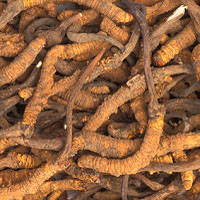Penn Herb Wellness Guide
CordycepsFind Products
 © Martin Wall
© Martin WallHow It Works
Cordyceps contains a wide variety of potentially important constituents, including polysaccharides, ophiocordin (an antibiotic compound), cordycepin, cordypyridones, nucleosides, bioxanthracenes, sterols, alkenoic acids, and exo-polymers.3, 4, 5, 6, 7, 8, 9
Many studies on the medicinal effects of cordyceps do not give a clear picture of its actions because many of the studies (1) are in animals or test tubes; (2) use different species, preparations, and intake levels; (3) inject cordyceps and/or its constituents rather than administering them orally; or (4) are not available in English and, therefore, cannot be reviewed for accuracy and design.
There are some clinical trials supporting the efficacy of cordyceps, particularly for liver, kidney, and immune problems. A number of studies indicate that cordyceps may have a anti-cancer, anti-metastatic, immuno-enhancing, and antioxidant effects.10, 11, 12, 13, 14
How to Use It
The recommended intake of cordyceps is 3 to 9 grams taken twice daily as a liquid extract, as food, or as powdered extract.15
Copyright 2025 TraceGains, Inc. All rights reserved.
Learn more about TraceGains, the company.
The information presented by TraceGains is for informational purposes only. It is based on scientific studies (human, animal, or in vitro), clinical experience, or traditional usage as cited in each article. The results reported may not necessarily occur in all individuals. Self-treatment is not recommended for life-threatening conditions that require medical treatment under a doctor's care. For many of the conditions discussed, treatment with prescription or over the counter medication is also available. Consult your doctor, practitioner, and/or pharmacist for any health problem and before using any supplements or before making any changes in prescribed medications. Information expires December 2025.


